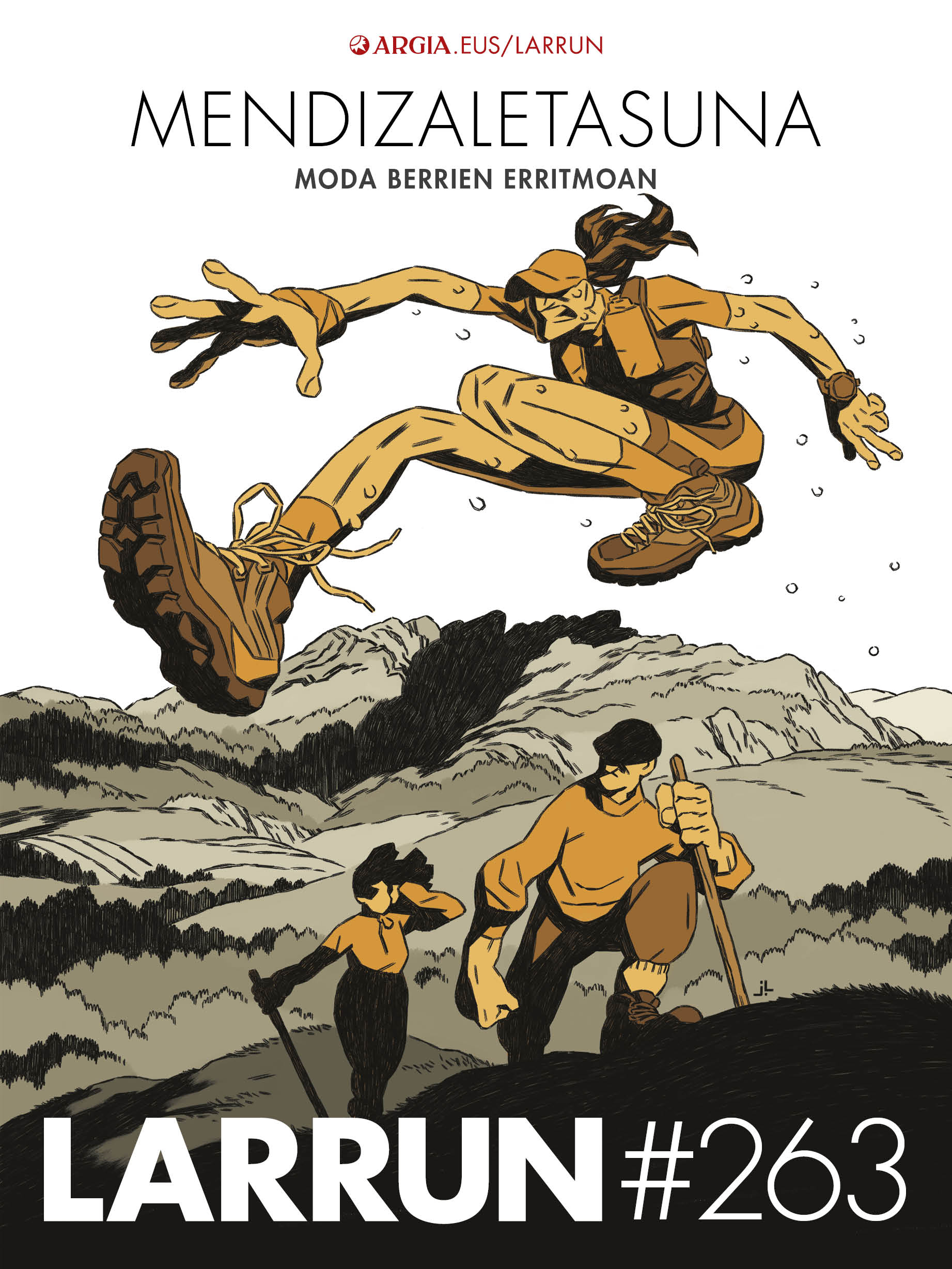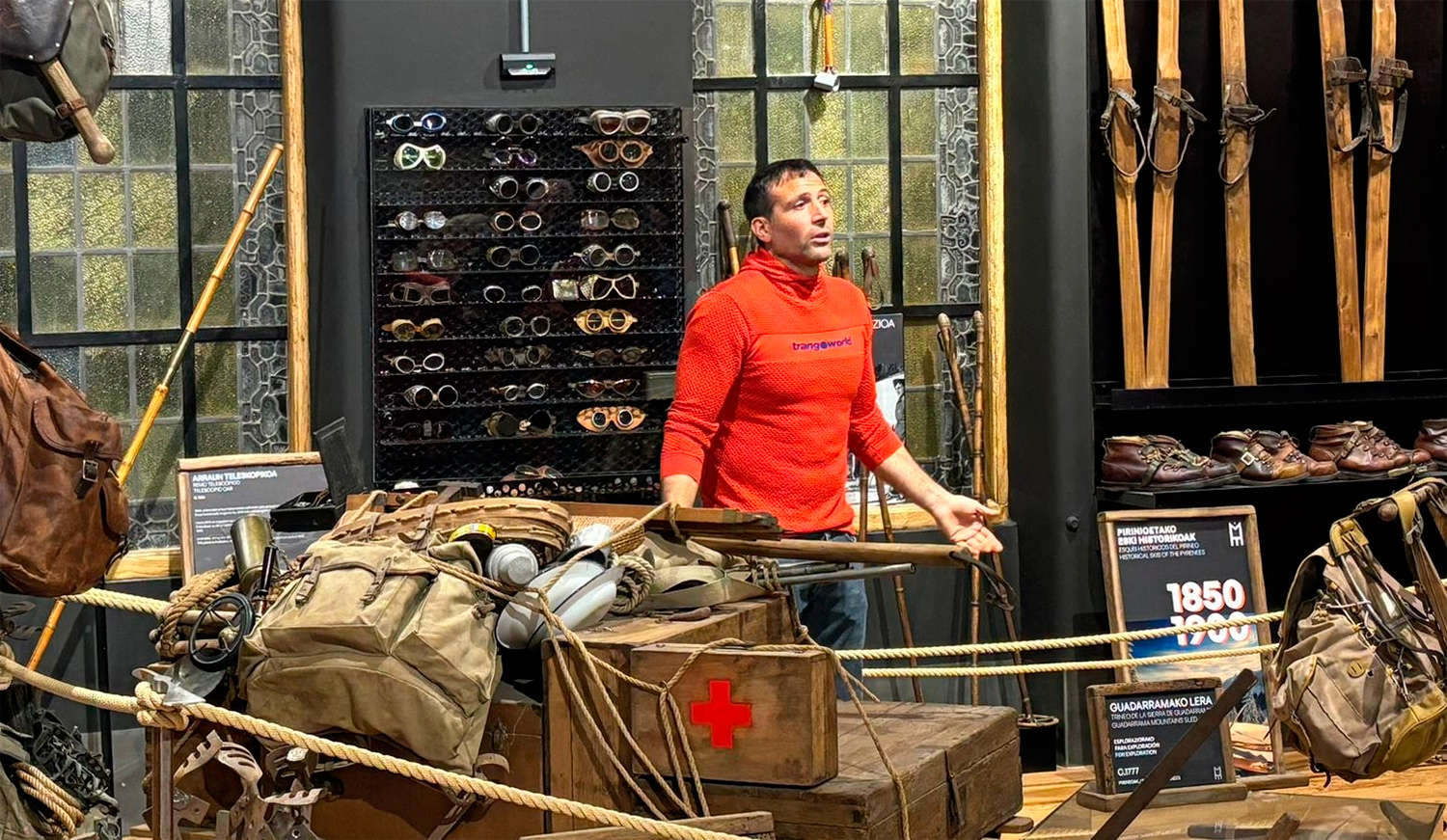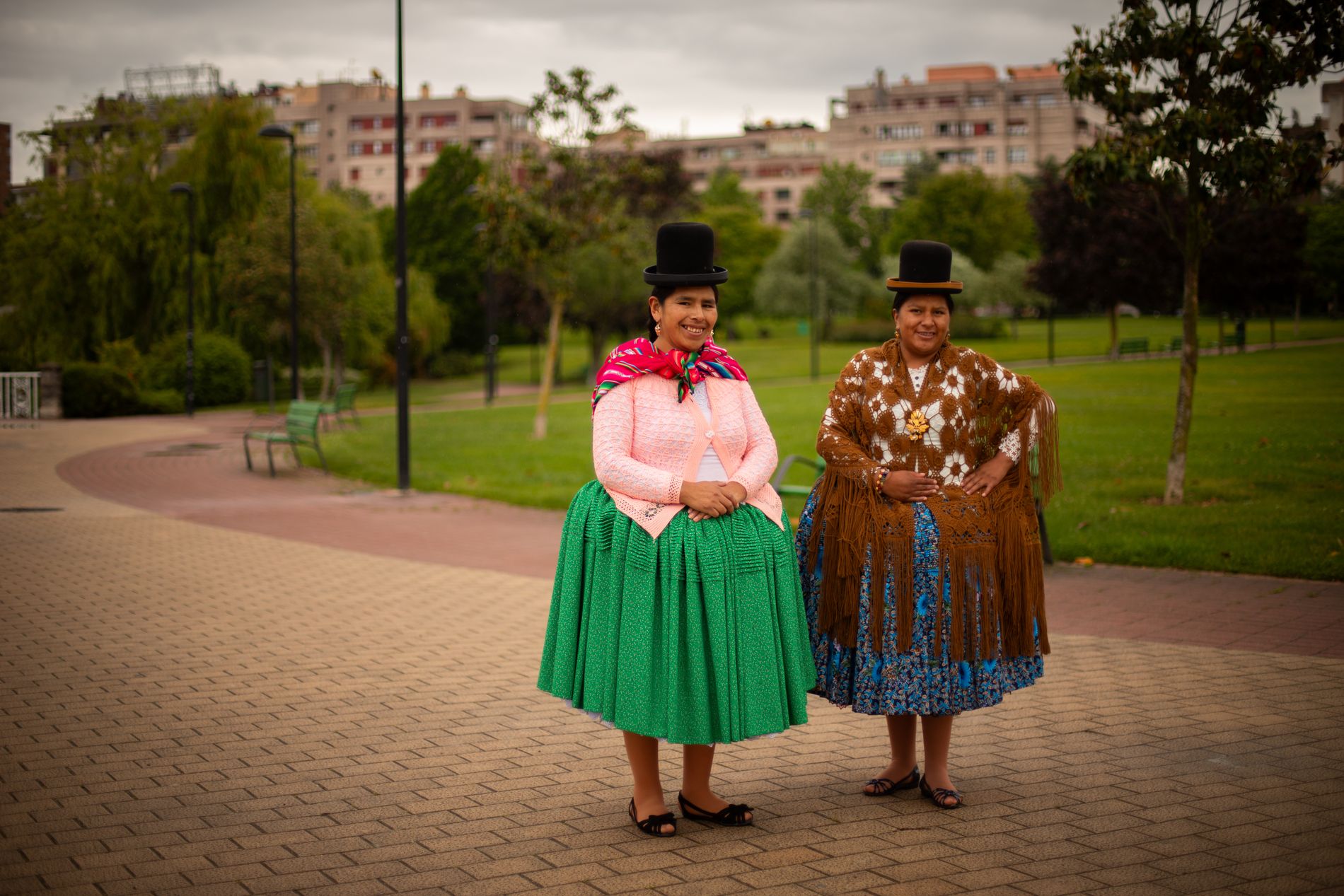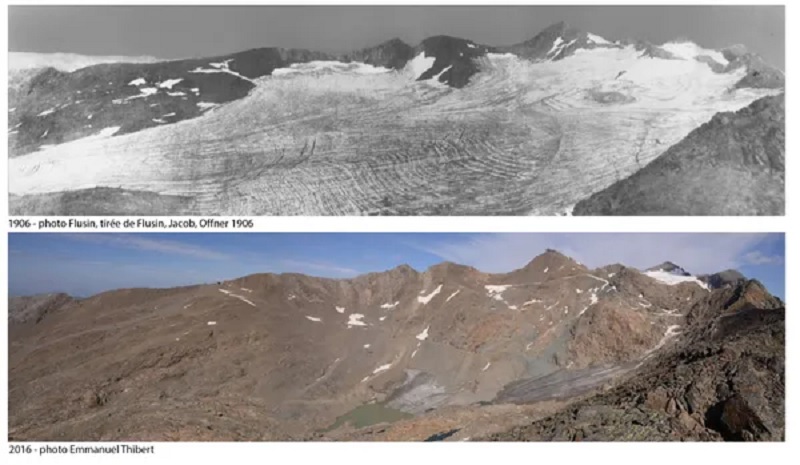Mountain climbing: At the rate of new fashions
- Someone has written "sit quietly" in the wooden seat between Larrea and Ipuliño, in the Uzturre mountain range. Declaration of intent. For about ten years, and especially in the midst of a pandemic pig that has squeezed us, the mountain has become a breathing space for more and more people. There are many young people, who are in a good shape and run like wild goats on the roads turned into “athletics tracks”, as some of the old schools say, not so much as criticism or as a testimony to the change that mountaineering experiences, but as an expression that the past times were more authentic. It is not the intention of this report – and we would also be lying – to show that the philosophy associated with mountaineering, which we could also call “culture”, has completely disappeared and that the speed, individualism and competitiveness that today’s society has as symbols have invaded all the paths, unless the influence of technology or mountain racing is analyzed. Juanjo Garbizu, author of the books Monotherapy and Slow Mountain, tells us about the benefits to the body and soul of walking peacefully through the mountain. We have also been with members of the groups Alpino Uzturre de Tolosa, Lagun Onak de Azpeitia and Ostadar de Zumarraga-Urretxu, because the experiences of these years are a reflection of the evolution of mountaineering.
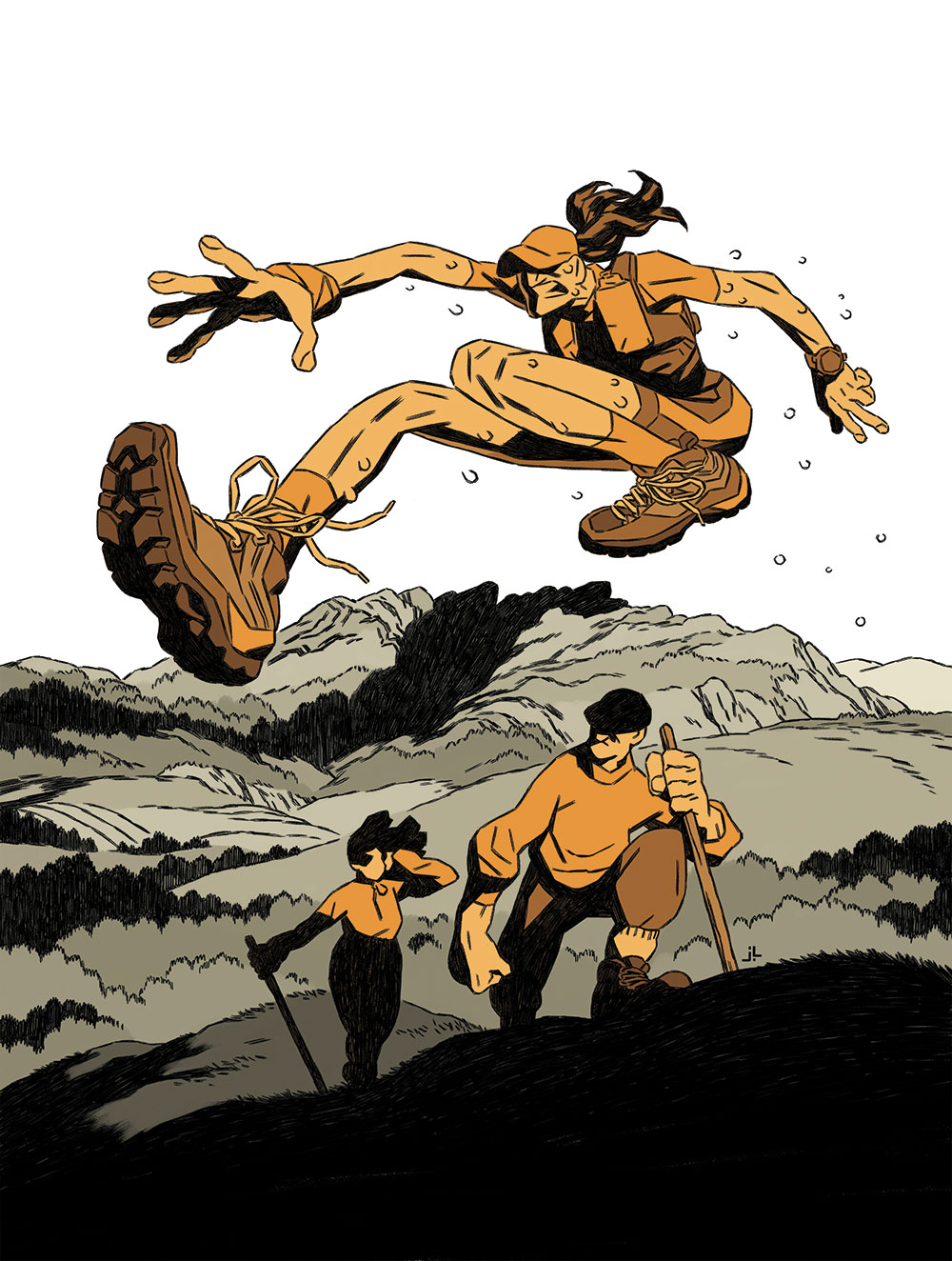
Aitor Oiarbide, president of the club Alpina Uzturre, has commented in detail on the milestones that have marked the evolution of mountaineering over the past 30 years. In the 1990s, there was little information about the mountains, with the exception of some maps and books, and those who wanted to know the new sites went to the local association. Until the arrival of the Internet, around the year 2000. Little by little we could get more information about the mountain excursions without leaving the house. All kinds of information, photos, maps... Ten years later, we could take all this material in our pocket, on the phone that we control with just one finger, which also has a revolutionary service that has radically changed mountaineering: Global Positioning System or GPS.
Over time, applications to upload tracks or routes, and brands, such as Wikiloc or Strava, spread enormously. Many people use them before leaving the house – to plan the route – when they go on the mountain – to check that it is the right way or to measure the times – and once the tour is finished, in combination with social networks, to make that information available to anyone and, in some cases, to extend the feat made to the four winds, in order to gather a range of lichens. They call it "posture."
The mountain racing boom of the return of 2010 is closely linked to social networks, which attracted many young people and introduced “competition” on the mountain, as Oiarbide says. And this flourishing has led to the mountain material evolving enormously in terms of lightness and security, escaping the transformation that mountaineering experiences.
In the meantime, almost all of us earn enough money to buy the car, if not a camper or camper. And they've built us roads that will lead us to the hillside of the mountain at a time when there was no other way than to travel by public transport or by buses organized by mountain groups. It took three or four days in the Pyrenees to climb a single peak and return home, which necessarily marked the rhythm and philosophy of the mountaineers.
Mount, training track
“If we want to spend as much time as possible on the mountain, now many people want to spend as little time as possible.” Juan Mari Gabilondo Txibis, Manuel Iraola, Joserra Lanberri and Luis Albisua, from the Ostadar group, speak of ancient times. “In the years 1960-70, we needed four or five days to go up to Aneto. We would train to Altsasu or Pamplona, sleep in a meadow, the next day to Benasque, the next day we would walk to the shelter, then to the top... Now almost everyone has a car or a motorhome, and there are roads of Christ. People go up and down a mountain the same day, spend the night in a van, and the next day, maybe they go up to another peak. Who are the Christians who today make 10-12 hour day trips with a large backpack on the back? We just looked at the clock.” It couldn't be otherwise.
Before leaving, it was convenient to do domestic tasks honestly: study guides and maps, decide the route... “The Erotic of Training”, as Juanjo Garbizu, author of the book Slow mountain (Diéresis, 2016) says. “Now we don’t have the time or the desire to do so. The mountain is losing the romantic touch and it makes me feel sorry. Everyone who respects him has the right to move freely, but I find it strange that when I see some runners coming down on the slope upon reaching the top, being so beautiful to be quiet on the top. I think that person running is an athlete rather than a mountaineer.”
“The mountain has become a training area,” says Oiarbide. “It’s an attractive environment and it’s normal that there are more and more people running, just like the races that have emerged in recent years. It is good that there is everything.” After all, there are other reasons to push someone to the mountain, flee something and search for something at the same time, you have to adapt to yourself: long or shorter trips, simpler or technical roads, climbing, skiing, running, cycling...
"If we go uphill, instead of turning our eyes, looking bad at the ground and listening only to our breath-taking blows, we will not absorb the landscape, the sound and the smell of our environment." Juanjo Garbizu
Over the past 15 years, the most important changes have come with technology and corridors and people on mountain skiing, according to Alpino Uzturre president. “Careers have attracted many young people and have also brought this point of competitiveness to the countryside, when until recently it was not so evident.” In the past they also made fun, very long journeys, wagering between pastors... And we would be lying if we were to say that in the high mountains there have never been ego fights or fights of interest. But the new trends have brought to another dimension the competitiveness of the Olympic motto Citius, altius, fortius (Faster, higher, stronger). Luis Albisua of the Ostadar group told us that 20-30 years ago he also ran, but as a training, “going strong to the Pyrenees” was not an objective in itself. “For the veterans, running on the mountain was a mortal sin.”
“With the term Slow Mountain I don’t mean that we have to act like turtles, but that offering each thing its time has a positive therapeutic effect,” says Garbizu. “We will not absorb the landscape, the sound and the smell of the area, if we go uphill, instead of turning our eyes, looking wrongly at the ground and listening only to our breath-taking blows. The theft of seconds or minutes when we go under the clock is the only thing that satisfies us in the background. In the city we are moving faster and faster and when we go to the mountain we are not able to relax and go slower.”
“Kilian effect”
Competitiveness has brought with it a huge development of the material, as the manufacturers have found the hayedo, which is good for all mountaineers, as the new products have evolved a great deal from the point of view of safety: slippers with outsole to avoid slips, crampons, piolets, ski equipment... Every year we can find better products. And lighter. “Today you’re going to see very few people with mountain boots,” say the Rainbow. “There is a tendency towards minimalism. Special Sneakers, Small Backpack, A Dwarf Raincoat... And the same with food, energy bars and others.” Garbizu compares what we would find in a gym: “Enter an energy chute and go ahead.”
“People have Christ’s material,” says Aitor Unanue, a member of the club Lagun Onak: “A Azpeitiarra sent me a photo of Erlo in winter, in the snow, crampons at the feet, piolet, pointer material... What and to go up to the Lot? ! You may be more likely to harm yourself dressed so if not.” “Joxe Urbieta Takolo went with less to the Everest,” says Josu Izagirre, remembering the 1980 expedition. And Unanue adds: “Benantxio also seriously told us that he saw in the shamanic bars better than in the base camp of Everest, when he was in the Txikiteo. People don’t have material problems, it’s about using them properly.” ==Death==Benantxio Irureta died in 2013 in Aneto.
In Garbizu’s words, social networks are one of the main allies of the new trends: “The videos that upload athletes, manufacturers of specialized materials and media mark the trend. The way we approach the mountain and the equipment used have changed dramatically from the 1980s to the present day. Trail circuits and so-called vertical kilometers, modalities related to competition, have attracted new people, for them the mountain is a circuit, a circuit as beautiful as hard.” The author of the book Slow Mountain calls him “Kilian effect”: “To start writing it, I realized that in specialized journals, such as Pyrenaica, ultra trail races occupied an increasingly wide space, because they are bisually very strong. This, of course, hugely attracts material manufacturers. If you show it in a promotional video on the Innominata shore of Kilian Jornet Mont Blanc, recorded with a slow-motion drone... They're shocking images."

“I admire Kilian!” he tells us when we asked him about Catalan. “He is an exceptional person and a great athlete, in his best way than Nadal or Messi. But I think the character has killed the person... In the documentary Path to Everest he narrates how at a given moment he hit the bottom for media pressure, because what he likes is to run and leave him in holy peace. It is a reflection of the current consumer and media society. Look, until recently there were two clothing seasons: spring-summer and autumn-winter. And now there are up to six! It is a consumption of ‘use and throw’, to which mountaineering has been partly dedicated.”
It was Kilian Jornet who wrote Iker's career. North Road (Unai Ugartemendia. Preface to the dialogue book Deslevel, 2020). The mountain corridor of Amezketa speaks with great sincerity of what has been experienced during these years. In a passage like this, Carrera: “It has always seemed to me that mountain racing is very unbalanced compared to other sports, that is, that there is a great difference between those who move around this sport and those who win the corridors. When I say what surrounds them, I mean organizers, brands, magazines or social media. The number of people living in their environment is much higher than that of the corridors, and that seems to me dangerous for the health of a sport and for the future.” And a little later, the quote that endorses the words of Garbizu: “I’ve never felt comfortable on networks, but I have to acknowledge that mountain racing growth is closely linked to social media. (...) My impression was that those responsible did not look so much at our calendar, and that each one looked more at the number of followers they had on the networks.”
“I still find it curious to see in the areas of the area, in Aralar or in Aratz-Aizkorri, stations or trail circuits, as I relate them to competition sports,” Garbizu continued talking. “Such infrastructures can contribute to the recovery of the local economy, but... I have nothing against the runners, but if it is not because of the scars they leave on the mountain, because they prefer to pass a ‘silk’ through places where there was no way before to not waste seconds.” The Zegama-Aizkorri race, which has also become an international benchmark, is an important factor in the “career trend”, according to the interlocutors.
Expansion of the collection
It is not known whether the term tachacimas in Spanish has equivalences in Basque. We are led by a “draft summit” to define the person who takes their names off the list as the mountain goes up. Garbizu frequently uses this term: “Many mountaineers aim to accumulate as many tops as possible, chaining two or three in one spin. It is not just a question of quality, the quantity is also of great value. Miquel Capdevila has a book that explains how to climb in 30 days all three thousand of the Pyrenees. This awakens the passion for raising the three thousand among young generations (using the term tresmilitis), leaving aside the lower mountains of great beauty.”
"The mountain has become a training area. It is an attractive environment and it is normal that more and more people are running, as are the races that have emerged in recent years. The races have attracted many young people and have brought this point of competitiveness to the mountain.” Aitor Oiarbide, Alpino Uzturre
“Of course we wanted to go to summits that had never gone up, the higher the better, 2,000 meters, 3,000... and if we were around four thousand, we would go there,” the Rainbow tells us. “We wanted to go up Lost, Aneto... But we said it before, we needed days to climb a peak of the Pyrenees.”
“It seems that ‘mountain’ and ‘peak’ are inseparable when you can make beautiful circular crossings without stepping the top,” says Garbizu. “In addition, people don’t stay at the top, but it’s a step like a career revival post. ‘The accumulated ascension’, ‘the total mismatch’... increasingly more important, athletes find pleasure there.” As many find pleasure on social media. It also uses Facebook to be closer to the readers and Youtube to disseminate the videos that it records on the mountain. But he always thinks of a phrase that he read somewhere. “Don’t go up the mountain for everyone to see you, but for you to see the world.” Another recommendation is that one of the tricks to enjoy the mountain calmly is to stay once again to make photos and record videos.
Learning by losing
All partners agree that technology, and in particular GPS, has been a breakthrough, as well as meteorological and emergency service warning applications (112 SOS Deiak, Safe 365...), as people can more control the environment and external factors and when it is put in black it takes less time to locate and rescue the mountaineer. Before we had to go down from death to a friend to call by phone from a shelter or house, abandoning it. “And how many times we lost ourselves!” says Unanue: “We thought it was normal, though. As soon as we left the house, we knew that we lost ourselves at some point.” According to Garbizu, getting away from the right path allowed for a better understanding of the mountain, and oneself, between brawls and brawls: “He was also part of the ritual. I had Miguel Angulo's book, but I don't know the top of the journey: let's go from here, then there's a source, then the neck, the edge, and we've come to the top. What to do at the middle crossings, not to mention it. If someone managed to get to the top only with the help of the book, they deserved a diploma. But that's how we learned. It was part of the training.”
It is true that technology offers greater security than books of yesteryear, but at the same time the dependence on new devices and applications is steadily increasing, to focus more attention on a ten-centimeter screen than on the elements around us. In addition, they can give a “false” sense of security and encourage people to act in a reckless way.
Like sheep, I submit to the shepherd
“Once we were making a GR, among the trees zigzagging, now on the left, now on the right, in front of me and behind all the members of the team,” Unanue began to tell us. “When I got out of the forest, I was approached by some and asked: 'How did you know where to go? '. There were no arrows on the road! But that has happened to us as well. When we went to the Pyrenees, always behind Benantxio. At his death they go to the mountains with which he had climbed and often we did not know where to go at the crossings. His wife said to us, “You are used to driving someone else!” We realized the convenience of paying more attention on the mountain.” Josu Izagirre perfectly describes the situation: “They follow us like the flocks.”
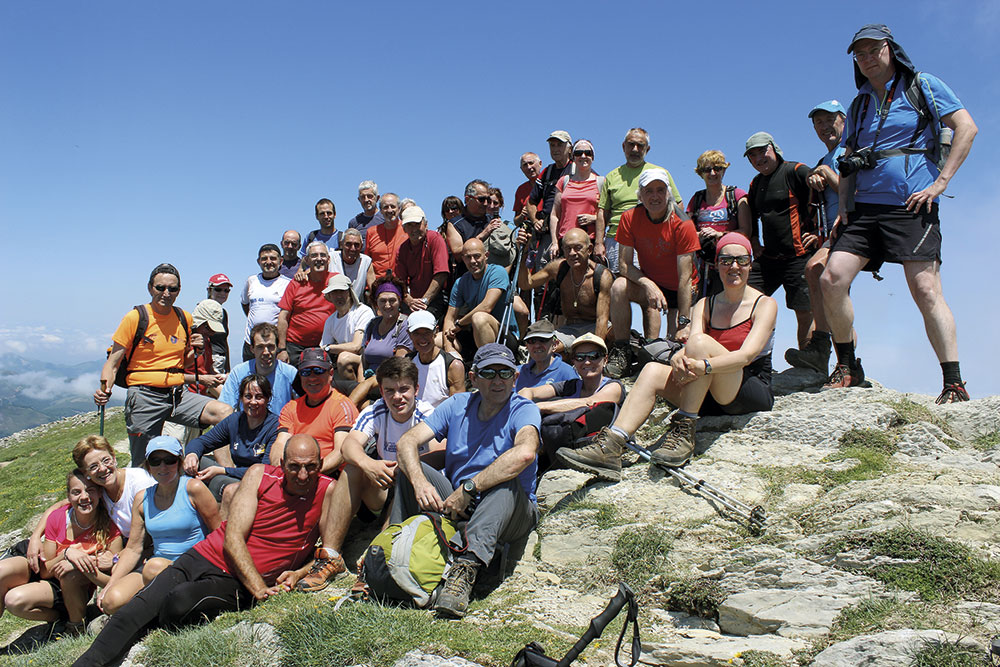
We now have virtual pastors saved on a small screen, and we faithfully fulfill their orders, a blue dot on the map. “Flipo,” Garbizu tells us. “Some mountaineers rely only on these tracks uploaded by people who don’t even know them. The other day I was coming down from Aratz with a friend, when he suddenly headed to the left. “Where are you going but?” I asked. ‘My GPS says it’s from here.’ I didn't, how to do, that I had often walked in those places. However, it remained very cooked, as the ditxoso track indicated something else. ‘All right, we’ll follow the path of your screen.’ We walked between brawls until we decided to go back. Sometimes we follow the orders of the new devices blindly, even if the eyes say there is something else that needs it. We have to use technology to help you in critical moments, but it can also discourage the senses, the sense of orientation, the intuition... If you're constantly looking at the screen, a lot of things will escape you."
Increase in the number of rescues
The data show us that in these times when we supposedly have greater control over our actions, more accidents occur on the mountain. As in recent years and especially during the pandemic mountaineering has increased, the number of rescues has increased.
In the CAPV, for example, in 1996 78 rescues were carried out, in 2016 there were 115, in 2018 267 and in 2019 331. The Ertzaintza Surveillance and Rescue Unit (UVR) reported on 16 January that the number of people rescued was about 30 for three weeks. Journalist Mikel Orbañanos published in Gipuzkoako Hitza (20-3-2020) a report on the reality that reflects these data. He gathered the statements of several experts, including the director of the Gipuzkoa Mountain College, Igor Lasa. He said that many accidents are related to lack of experience: “Only 15% of mountaineers who suffer accidents are federated. There are many people who come to the mountain without sufficient knowledge and, at the same time, too daring.” And that has to do with technology, because a lot of people think it's enough to download the track of the excursion to be able to walk on the mountain without problems. When we rely on virtual applications, we stop thinking for ourselves, and if that capacity is lost, it will be harder to make the right decisions when more than half of the accidents are caused by “wrong choices”.
“Many people who meet me on the mountain have a point in an immense way,” Garbizu tells us. “I don’t know if it’s because they come from the gyms, but you see them and the paw, how they climb the cannons so they have never gone to the mountain before. But the mountain needs a knowledge that experience brings. Because you can think that on a sunny day, you won't have any problems, but you can get the fog abruptly or blow up the storm. The mountain can be an aggressive place. And you see people with those sneakers, a backpack on the back ... If everything goes well you don’t need more, but in case you should be better equipped, let’s not say in the Pyrenees.”
"Benantxio seriously told us that he saw better breasts in bars than in the base camp of Everest, when he was in the Txikiteo. People have Christ’s material, it’s about using it properly.” Aitor Unanue, Lagun Onak
It tells us about the “frivolization of the mountain”, the frivolization of an environment in which unforeseen events can be saved. And that relates it to the use of social media: “There is nothing more to do with how many of the most well-known summits of the Pyrenees are described. The 25-kilometer and 1,800 meter positive rides are ‘walks’ and the complicated paretons ‘anyone can climb’. This causes stress, it's not healthy. One day, walking down the Roya Canal (Pyrenees), I found a man and his son near the parking lot, dressed in beach chanclets. ‘Forgive me, do we lack much to reach the lakes?’ my father asked. ‘There is no lake around me.’ ‘Yes, from Anayet’. Well, they didn't want to go to the Anayet Ibons! I asked him if he went crazy. I hope they will turn around.”
Recalling Gredos' claim
On March 29, 2013, a mountaineer in Mungia died in the Sierra de Gredos (Spain) from fatigue and hypothermia. Alpino was a member of the mountaineering exit organized by the Bilbao team and was charged with “involuntary homicide” to the club president as a possible responsible person. The accusation was based on the figure of the good will driver, of the person who altruistically accepts the leadership of the group. A year later, the suit against him was filed, since the judge could not be held liable by failing to sign a contract that recognized him as a driver.
This disaster caused a great stir between institutions, mountain federations and clubs, due to civil liability obligations, and if until then “quiet” outings were organised, it scared everyone a little. Those in the Ostadar group, for example, stopped travelling to the Pyrenees. “By the Midi d’Ossau, we would now do something like this! What risk we assumed... Not all team members had the same level of form or experience and...”.
“Professional drivers have been hired to go to unknown places,” Lagun Onak explained: “The responsibility in the end is yours and in case ... If not, there are no great differences between the professional driver and the “goodwill” driver. What happens is that someone has to do that and that many people don't want it, so there's no problem.
Teachings on bus trips
The issues of civil liability have enabled us to talk about the activity of mountain associations and the challenges of the future. One of the advantages of going in groups is, or was, traveling by bus because it can be left in one place and received in another and because of its social burden. Clubs are good schools, as people of different ages can learn something from others. The one who knows the most teaches the collateral and the latter to the other, giving continuity to the transmission rope.

In this sense, Luis Albisua of the Ostadar group presents us with a bit pessimistic: “Young people have such a wide range of leisure options... If I were the same age, it wouldn't come to us anyway. I've belonged to the club since 1982, but I had a time when I went to the mountain with a couple of friends and not to the exits organized by the Rainbow. We have become a little obsolete, it seems that we are only dealing with the federated documents. I tell the young people to cheer, we're going to retire. But nobody wants to take care of it. There is no relay.” Many groups have not organized outings during the pandemic. One of the few exceptions is Lagun Onak de Azpeitia, one of the largest in Gipuzkoa (in the first quarter of the year it had about 1,000 members, half federated). Also in these crazy times he has maintained his activity, organizing walks and competitions appropriate to his state of health, such as the #GazteErronka, which aims to show less known routes to ascend to the mountains of the town. “For children it is very enriching to go in groups. The idea of creating the project came to us from a school. It made us excited because it arouses interest in the mountains of the area and is a good opportunity to learn, for example, the basics of orientation.”
Unwritten laws
In short, knowing the environment implies a greater willingness to care for it. At least that should be the case. But where so many people come together...
“Dad, do you know all of them?” the son asked long ago, seeing that the old man was dismissed from anyone who was in front of him. He soon learned that there are two unwritten laws that every mountaineer should comply with. To say goodbye to everyone and to the fact that those who go down have to leave room for those who go up. Basic subject “Culture”. “All this is being lost. It is noted that there are more and more people who did not have a custom in the mountain,” says Garbizu. “Many, not even looking at the face. And the trash, the noise ... Some just look at him. Individualism prevailing in society, also in the midst of nature”. The one who carries within the mountain almost always dismisses as a gesture of courtesy and, in places not frequented, to make sure that the other mountaineers have seen what happens. “This point of complicity is important,” explains Oiarbide, “I find it hard not to greet myself.”
"Some mountain groups have become a little obsolete, it seems that we are only dealing with federated documents. I tell young people to cheer, but there is no relay.” Luis Albisua, Ostadar
Unanue works as a walker in the Council of Gipuzkoa, wiping out margins. Last winter he moved to Urraki with snow. “Cars were parked on both sides, hampering the road. We asked us to move, because there was no room that had to pass an ambulance, and people didn't catch us! Some introduce cars into the meadows of the farmhouses. Does the farmer intend to simulate what? They tell you ‘the mountain belongs to everyone’.
Problems arise more than “everyone” when people think that the mountain is “their own”, as is the case in other areas of society. In short, the evolution of mountaineering cannot be understood without taking into account the changes that are taking place in society, although, as some people argue, we should enjoy the mountain more calmly, avoiding that point of stress that the daily life entails.
* * * * * * * * * * * * * * * * * * * * * * * * * * * * * * * * * * * * * * * * * * * * * * * * * * * * * * * * * * * * * * * * * * * * * * * * * * * * * * * * * * * * * * * * * * * * * * * * * * * * * * * * * * * * * * * * * * * * * * * * * * * * * * * * * * * * * * * * * * * * * * * * * * * * * * * * * * * * * * * * * * * * * * * * * * * * * * * * * * * * * * * * * * * * * * * * * * * * * * * * * * * * * * * * * * * * * * * * * * * * * * * * * * * * * * * * * * * * * * * * * * * * * * * * * * * * * * * * * * * * * * * * * * * * * * * * * * * * * * * * * * * * * * * * * * * * * * * * * * * *
Any change creates mistrust
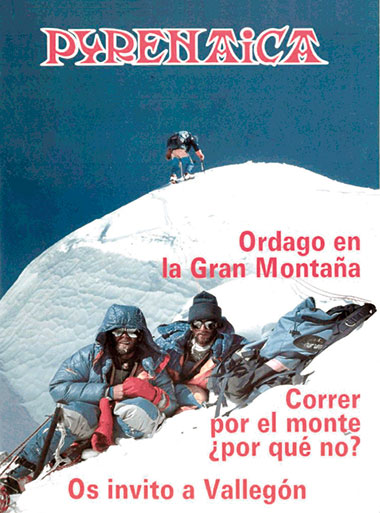
"Mountaineering is constantly changing, evolving. Some modalities would seem to us to be science fiction a few years ago. Mountain skiing, extreme, very ambitious individual climbs, bulder, descent of cannons, or flight deltan… And in 1985, Himalayan marathon, in which many of the participants came from the mountain world.”
We have taken these words from a report published in number 144 of the Pyrenaica magazine of 1986.Tenthe signing of Casimiro Bengoetxea and Jesús Mari Alquez, and as a title: Mendia .. Zergatik ez? (Running down the mountain… Why not? ).
“To tell the adventures that he has run on the mountain, I was a little afraid,” he was speaking to each other. “Haven’t you remembered Pyrenaica’s skin, from which a man appeared climbing in shorts? A lot of letters to the director, which was not mountaineering, which would be better in the circus… And now, we both come with the theme of running in the mountain… Recently, had you not proposed that any of the mountain departures of the schedule of excursions be completed walking and running? And what happened? They send the geese to herding...”
According to Juanjo Garbizu, author of the books Monotherapy and Slow mountain, “this article challenged the classic mysticism of the mountain”. In any case, it shows that the career is not a new phenomenon, nor the appearance of different points of view about this activity, although the runners of that time faced the challenge with another philosophy, as can be read in the report: “We must be mindful that this is not a popular race, nor a competition, and that it is not a matter of breaking records. You have to take it calmly. We will stop when the landscape deserves it, when the fogs of the morning have surpassed or reach the hill that will take us from one valley to another. We will not be in a hurry. The goal is not to break marks, to act against the clock.”

Let us now go further back in time, in the years 1950-60, to remember the writings of the Italian journalist Dino Buzzate. Reading the articles in the beautiful book of chronicles I fuorilegge della montagna, which can also be found in Spanish, we will realize that the fascination with new activities and at the same time distrust are elements that are repeated over time. And also the motives that drive us to the mountain and its “spontaneous” philosophy.
"On those summits without glory or glory, whose name will not cause any surprise or praise to your friends, on the old peaks never contaminated by any competition, you will surely be very happy there, without knowing it." / 1948
"In Milan we have heard several people say: 'When do they stay? Why don't they ban it for once? What does this crazy tale of climbing bring? Is it acceptable that so many medical equipment, helicopters and doctors should be mobilized for a crazy whim of two or three people? '. There have also been those who have spoken more negatively: ‘Don’t start talking about passion for the mountain. This is nothing but exaggeration, the desire of people to speak for themselves, the desire to see in the newspaper the proper name’ (...) Let us accept. We need people who are looking for increasingly difficult challenges. The sick us, if they didn't exist." / 1961
"I wish the mountain of my life was more famous, one of the giants, what do I know? Civetta, Grandes Jorasses, Gaurishankar... Cervino wouldn't: it would be too common. Schiara, of course, is a bit provincial. It doesn't react in society. ‘I’ve climbed Schelectronica’s wall.’ 'What? How? Where? Nobody heard anything from him." / 1964
"Have you suffered the mountain? Much less than we can think, to tell the truth. Yes, the walls have been conquered, but... They're so big! (...) The passage of two or three cords has not changed anything. Although the abuse of artificial means can be partially justified (in recent years, where there were no cracks to nail, puncture holes were made), the nostalgia of the ‘clean’ style of other times is, in essence, excessive if we think that the extreme funambulists are relatively few.” / 1950
"Good morning." ‘Good morning.’ It was a common greeting among people on the mountain, a gesture of courtesy, which today knows why, that less and less is practiced." / 1963
"Why do the mountains cause such fascination? What characteristics do they make so special? I distinguish two of them, their abrupt lands and their immobility. Of course, the second is the most important. (...) The reason for me is man's tendency to seek total calm. What do people strive for day and night? What do you work for, make money, seek reputation and power, if not to be able to enjoy so many efforts in one day, to be completely free from so many commitments and bonds and rest? (...) Man tends unconsciously to conquer immobility. And that's precisely why the mountain, the perfect model of this situation, gives it a sense of complacency." / 1971
* * * * * * * * * * * * * * * * * * * * * * * * * * * * * * * * * * * * * * * * * * * * * * * * * * * * * * * * * * * * * * * * * * * * * * * * * * * * * * * * * * * * * * * * * * * * * * * * * * * * * * * * * * * * * * * * * * * * * * * * * * * * * * * * * * * * * * * * * * * * * * * * * * * * * * * * * * * * * * * * * * * * * * * * * * * * * * * * * * * * * * * * * * * * * * * * * * * * * * * * * * * * * * * * * * * * * * * * * * * * * * * * * * * * * * * * * * * * * * * * * * * * * * * * * * * * * * * * * * * * * * * * * * * * * * * * * * * * * * * * * * * * * * * * * * * * * * * * * * * *
Alone or in company?
Going to the mountain alone or with friends or family is a completely different experience. Both have a positive side. Being in a group creates a special atmosphere, an alliance of friendship between people who share the same hobby. When we go alone, on the contrary, the experience is much more introspective, more intense, talking only to ourselves, I don't know what account we think of. Longer and longer journeys, even deeper monologues, as Juanjo Garbizu says. “When you have been in the Pyrenees for eight hours without seeing other mountaineers... You have to have great self-control. You have a cell phone, you also have a GPS, but the situation can carry you at some point. Trust is gained over time. It is a ‘test error’, there is no more, like life itself.” He says that one of the greatest lacquers of today’s society is “our inability to be alone with ourselves”, as if I were to give it to us, and that mountain excursions allow part of that “shortage” to be filled. “When we go in group we have to adapt. When we are alone we can do what we want, you are the owner of your actions. You observe the environment with more attention and the obstacles or challenges that can be easily overcome in the group acquire a new dimension. When we have to climb through a few stones, if we leave with friends we may dare, but when we are alone...”.
* * * * * * * * * * * * * * * * * * * * * * * * * * * * * * * * * * * * * * * * * * * * * * * * * * * * * * * * * * * * * * * * * * * * * * * * * * * * * * * * * * * * * * * * * * * * * * * * * * * * * * * * * * * * * * * * * * * * * * * * * * * * * * * * * * * * * * * * * * * * * * * * * * * * * * * * * * * * * * * * * * * * * * * * * * * * * * * * * * * * * * * * * * * * * * * * * * * * * * * * * * * * * * * * * * * * * * * * * * * * * * * * * * * * * * * * * * * * * * * * * * * * * * * * * * * * * * * * * * * * * * * * * * * * * * * * * * * * * * * * * * * * * * * * * * * * * * * * * * * *
Walking and running, we're happy to be in nature
As we wrote this report, we sent a small questionnaire to a dozen people who walk or run down the mountain, not with the aim of conducting in-depth sociological research, but with the hope that from a few small details, they would come to some striking conclusion.
We received the answers on the blog.
On Sunday of September it is customary to climb to Ernio, dance in Zelatun and eat brown chorizo, or something. The worst time you don't need people. This year, when my friends were leaving earlier and I was delaying, I would go up alone, finding the crews coming down. Most young... [+]









